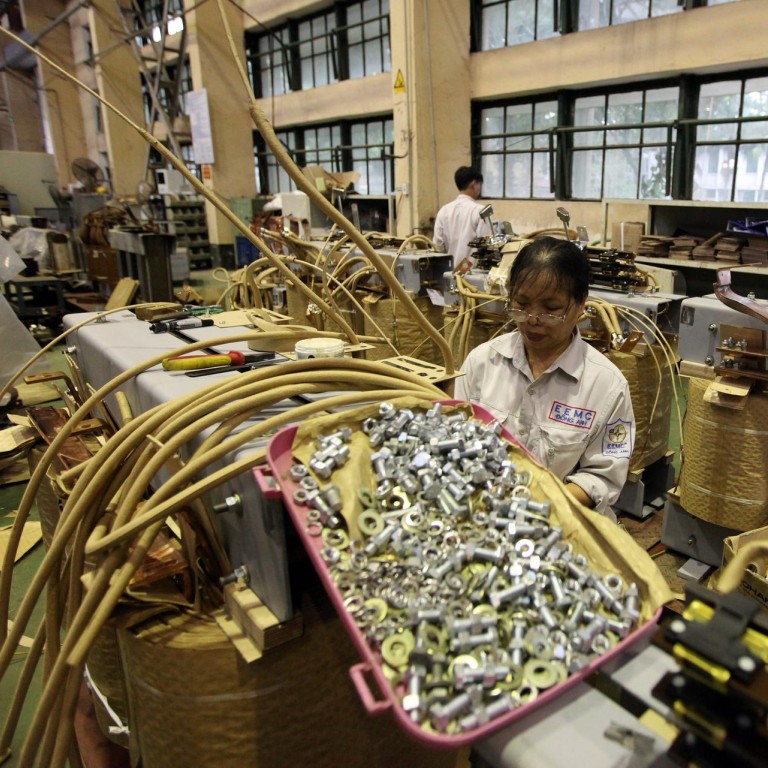
New | Manufacturers step up search for low cost alternative to China
Higher mainland wages have forced labour-intensive industries such as apparel to find cheaper locations, with Vietnam one of the beneficiaries
The exodus of factories moving out of China in search of lower-cost options in southeast and central Asia is accelerating, as manufacturers face increased pressure to reduce unit costs.
Few industries have been spared amid the search for cheaper manufacturing alternatives, with rising Chinese labour rates cited as a major concern affecting industries as diverse as apparel and high-technology.
Japanese electronics giant Panasonic Corp announced in August that it would close its lithium-ion battery factory in Beijing and cut 1,300 jobs. Taiwan's Foxconn, a handset manufacturer for brands such as Apple and one of the biggest exporters out of China, also announced in August that it would invest US$5 billion in India to build assembly plants. Meanwhile, South Korean tech giant Samsung Electronics will invest an additional US$3 billion in Vietnam to ramp up its existing facilities.
In a survey conducted by the US Fashion Industry Association, China scored the lowest among 27 destinations in terms of the tendency of US fashion brands to increase sourcing in the next two years, whereas Vietnam and India scored the highest.
"The change is significant in the past two years, the cost of labour in China has become very high, growing at least 10 per cent every year," said Peter Hopper, Partner at Strategic Decisions Group (SDG), a management consulting firm specialising in strategic decision-making.
Hopper said one of his firm's clients, a luxury handbag brand, trimmed its sourcing from China to 5 per cent from 80 per cent over the past two years to cut costs.
Wages in China have increased dramatically since 2011. In Shenzhen, where Foxconn's "campus" factory is home to more than 200,000 workers, minimum monthly wages in the city jumped more than 50 per cent in the past four years. In each of the past two years wages have jumped more than 10 per cent, lifting the average monthly salary to 2,030 yuan.
Rising sourcing costs have been cited by companies as the main reason they are looking to relocate. Because global consumer demand is weak, brands are finding that they cannot pass along higher prices, and instead must focus on production costs.
"As the global economy slows, brands are less confident to push up finished goods prices," Hopper said.
The strength of the yuan is another factor putting the squeeze on manufacturer's margins.
Manufacturers have welcomed further weakness in the yuan in the wake of the PBOC's decision to allow the currency to depreciate by 2 per cent on August 11. Hopper said further devaluations could attract companies to stay in China, although officials will have to demonstrate that this summer's devaluation is not a one-off measure.
Other experts were less confident that a cheaper yuan would offer much help to struggling manufacturers. "The reality in the apparel industry is that it's really difficult to automate. So with China amassing wealth, labour intensive sectors will move out gradually," said Lian Hong Lim, managing director at consultancy AlixPartners.
China's loss has become Vietnam's gain. Vietnam is rapidly increasing its market share in manufacturing categories such as footwear, garments and electronic products. Vietnamese exports of footwear to the US grew 24 per cent in 2014, while China's rose only 0.3 per cent.
Vietnam's purchasing manager's index has signalled expansion for 24 consecutive months. In August, the PMI was at 51.3 points, whereas in the same month China's PMI fell to a six-and-a-half year low of 47.1.
"Considering both wages and productivity, the low-end production cost in Vietnam on average is about 30 per cent lower than in China," said Jugnu Sakuja, a senior manager at SDG.
The minimum monthly wage in Vietnam is US$145.
Sakuja added that tariff cuts, expected after Vietnam enters the Trans-Pacific Partnership agreement (TPP), are another attraction for manufacturers considering relocation.
Song Hong, a director with the international trade department at the Chinese Academy of Social Sciences, says in the next four to five years the factory exodus from China will reach a peak.
China has changed policies and aims to shift its manufacturing focus from low-end to high-end products such as computers and airplanes, he said.
"In the short term cities relying on labour-intensive manufacturing will be impacted," Song said. "For China, moving factories away is the easy part. The challenging part is how to upgrade the industries smoothly." Lim believes China still has the edge over its regional competitors when it comes to overall efficiency as a manufacturing hub. These include a robust supply chain, a skilled labour base and a well-developed logistics infrastructure compared to most Southeast and South Asian nations, Lim said.
"That said, it doesn't mean there will be a lot of increments in the manufacturing capability," Lim said. "A company can be very happy keeping its existing plants in China, and going elsewhere for the next plant."

